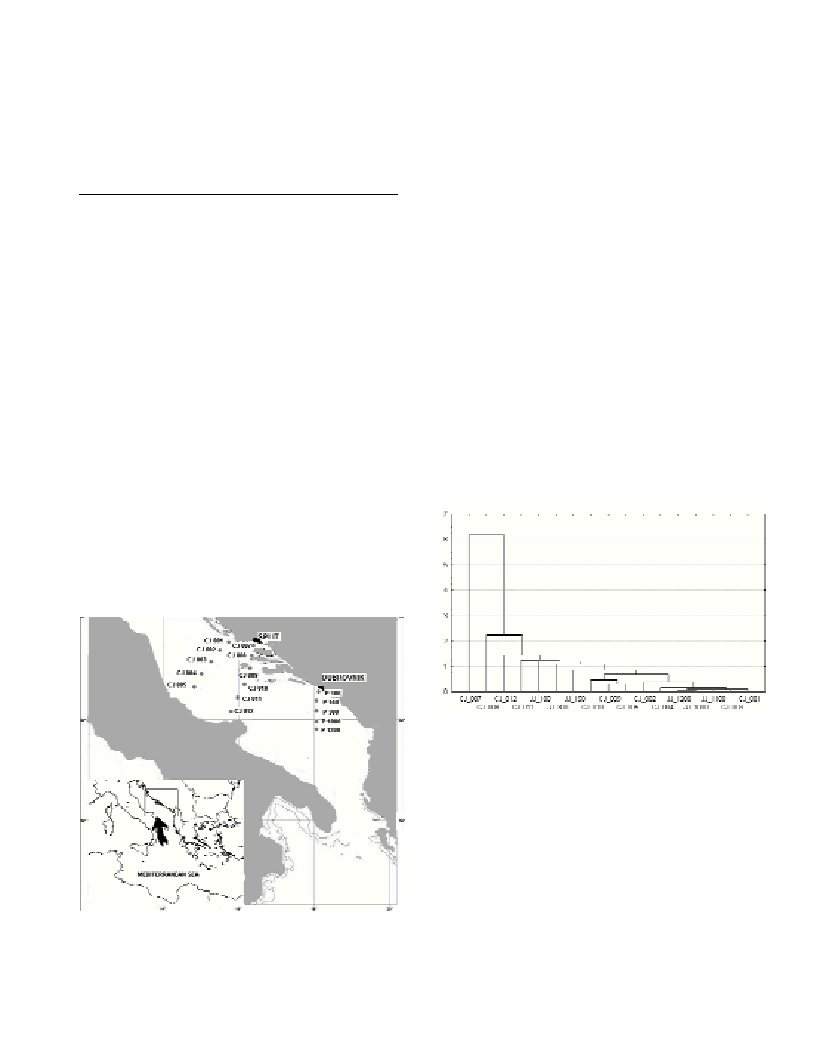FAMILY CANDACIIDAE (COPEPODA, CALANOIDA) IN THE CENTRAL AND SOUTH ADRIATIC SEA
Dubravka Bojanic
Institute of Oceanography and Fisheries – Split, Laboratory of Plankton Ecology, Dubrovnik, Croatia - dbojanic@labdu.izor.hr
Abstract
The family Candaciidae was investigated during nine cruises in the Central and South Adriatic. Six species of adults and their copepodites,
all of which were present in low abundance, were found typically in subsurface layers of coastal stations. These are the first data on the
abundance and distribution of the copepodites of this family in the Adriatic Sea.
Keywords: Zooplankton, Candacia, Paracandacia, Adriatic Sea
Rapp. Comm. int. Mer Médit., 37,2004
314
Introduction
Investigations of planktonic copepods in the Adriatic Sea began at
the end of the 19th Century, but were restricted to the Northern
Adriatic (1). Graeffe (2), among others, mentioned three species of
Candaciidae: Candacia longimana(Claus, 1863), C. melanopus
(Claus, 1863) [syn. C. ethiopicaDana, 1849], and C. bispinosa
(Claus, 1863). Steuer (7) found C. pectinata(Boeck, 1873)near Silba
Island and Dubrovnik, and C. bispinosa and C. simplex(Giesbrecht,
1889) in the vicinity of Dubrovnik. Nine species were collected from
1974-1976 during cruises of R/V Andrija Mohorovicic: C. aethiopica,
C. armata(Boeck, 1873), C. bipinnata(Giesbrecht, 1889),
C.elongata(Boeck, 1873), C. longimana, C. teniumana(Giesbrecht,
1889), C. varicans(Giesbrecht, 1889), Paracandacia bispinosa, and
P. simplex (6). Candacia armataand C. pectinatapreviously were
regarded as synonyms. A consistently smaller form, previously
considered to be C. armata, was described as a new species,
C.giesbrechti (3). Later investigations have shown that the larger
form, C. armata, is very rare. It thus has been assumed that most of
the previous data refer to C. giesbrechti.
This paper adds new data on the abundance and distribution of
Candaciidae, including life-history stages, in the Central and Southern
Adriatic.
Materials and methods
Zooplankton was sampled at 17 stations during nine cruises in the
Central and South Adriatic Sea (May 2002, June – July 2002, August
2002, September 2002, December 2002, April 2003, May 2003, June
2003, August 2003). Eleven stations were set along two transects in
the Central Adriatic (CJ stations) and six, in the eastern South Adriatic
Pit (JJ stations) (Fig.1). August 2002 was the only cruise when station
P-1100 was visited. In December 2002 two new stations (P-150 and
P-1200) were introduced.
A total of 196 samples were collected with a Nansen-type net
(diameter 57 cm, length 255 cm, mesh 200 mm) equipped with a
closing mechanism. Vertical hauls were taken in depth intervals of 50
or 100 m. Organisms were preserved in buffered formaldehyde. The
entire samples were examined in the laboratory using a Wild
microscope at a magnification of 400X. All copepodites and adults of
the family Candaciidae were counted. Adults were identified to the
species level. Results are presented as individuals per cubic metre.
Results and discussion
Six species of Candaciidae were collected: Candacia giesbrechti,
C. varicans, C. tenuimana, C. longimana, Paracandacia simplex, and
P. bispinosa. All were present in small numbers; in some cases only a
single speciman was found. The number of species decreased from the
south to the central Adriatic.
C. giesbrechti, the most abundant species (<3 ind/m
3
), was collected
mostly in subsurface layers of coastal stations. The same was true of
C. varicans, which always was less abundant (<2 ind/m
3
). P. bispinosa
was found at open-water stations along the PalagruĎa transect and in
the South Adriatic (<1 ind/m
3
).P. simplex, was encountered only in the
South Adriatic, and was most abundant at P-100 (<0.5 ind/m
3
).
C.longimanaandC. tenuimanawere rare in the deep layers of the
South Adriatic (<0.1 ind/m
3
). All copepodite stages were found at all
stations throughout the entire water column. Highest values
(<6ind/m
3
) were collected at the coastal Central Adriatic stations.
Based on average density and species composition, stations JJ-
1000, JJ-1100, and JJ-1200 were clustered in one group with great
similarity. They were associated with CJ-003 and CJ-004, which are
also open-sea stations. CJ-008, CJ-012, and especially CJ-007 were
separated by higher values, as is typical of coastal stations (Fig. 2).
Available data on Candaciidae in the Adriatic Sea relate only to the
frequency and distribution of species (4, 5). The present work adds
information on the abundance of particular species, and the first data
for their copepodites. This thus contributes baseline data essential to
planning future investigations of this family’s spatial and temporal
distributions in this region.
References
1-Claus, C., 1881.Neue Beiträge zur Kenntniss der Copepoden unter
besonderer Berücksichtigung der Triester Fauna. Arb. Zool. Inst. Wien, 3:
313-332.
2-Graeffe, E., 1900.Übersicht Fauna des Golfes von Triest, V. Crustacea.
Arb. Zool. Inst. Wien, 13: 33-80.
3-Grice, G.D., Lawson, T.J., 1977.Candacia giesbrechti, a new calanoid
copepod from the Mediterranean Sea. Vie Milieu, 27:263-271.
4-Hure, J., Kršinic, F., 1998.Planktonic copepods of the Adriatic Sea.
Spartial and temporal distribution. Nat. Croat., 7, suppl. 2:1-135.
5-Hure, J., 1955.Distribution annuelle verticale du zooplancton sur une
station de l’Adriatique méridionale. Acta Adriat., 7:1-72.
6-Hure, J., 1980.Zooplankton – Copepoda. Izvještaji rezultati oceanograf-
skih istraživanjaJadranskog mora, Hidrografski Institut, Split, pp. 187-202.
7-Steuer, A., 1910.Adriatische Planktoncopepoden. Sitzungsber. K.
Akad. Wiss. Wien Math. –nat. Kl., 119:1005-1039.
Fig. 2. Tree diagrams based on average density values of Candaciidae.

